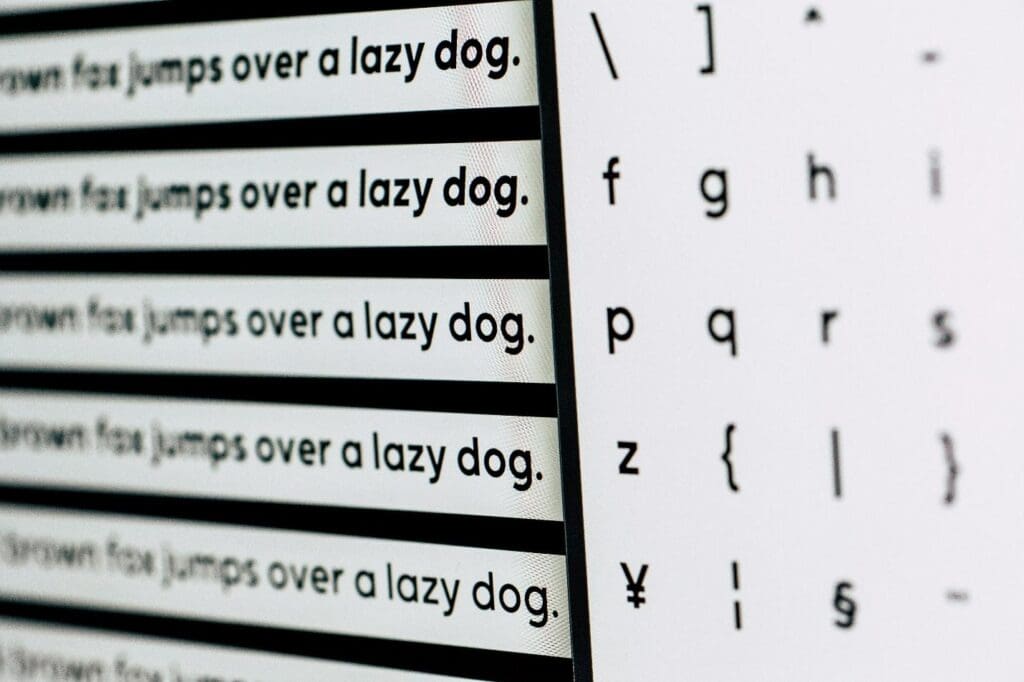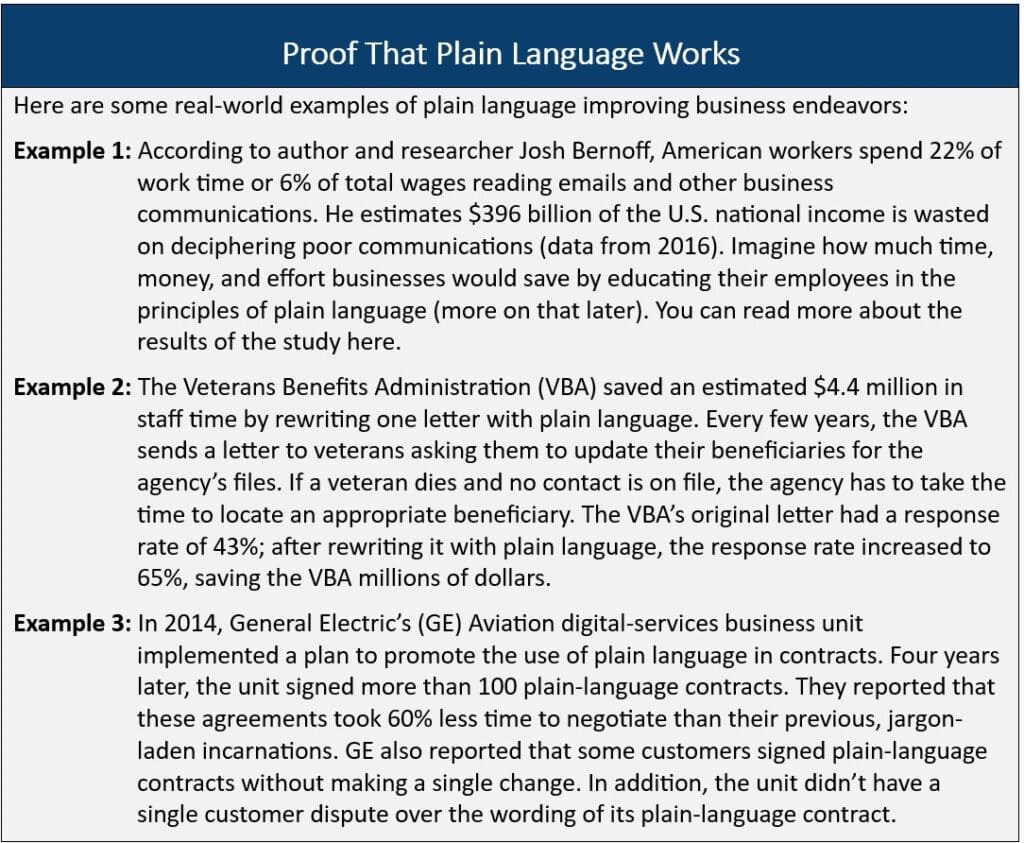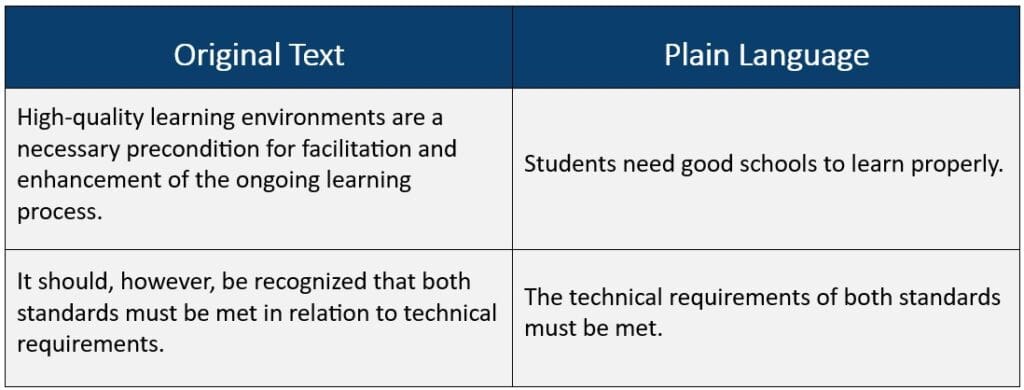The Power of Plain Language—How It Saves Time and Money

Whether fictional or factual, all writing conveys information. When a writer puts words to a page, they choose the words that best describe the facts and feelings they want the reader to know and experience. A writer must write clearly and intentionally or risk losing the reader’s attention. This is especially true in the fast-paced Information Age.
Though the Internet contains more information than has ever been readily available in human history, that information isn’t always easy to read. Too often, technical instructions and customer service guides lack explanation or context, and they offer jargon-laden advice that is only helpful to seasoned users. Considering that more than half of the adults in the United States read below a 6th-grade level, one point becomes clear: clear writing is a must.
What Is Plain Language?
You could say it’s the law. The U.S. Government passed The Plain Writing Act of 2010 to “enhance citizen access to Government information and services.†The Act defines plain language (or plain writing) as “writing that is clear, concise, well-organized, and follows other best practices appropriate to the subject or field and intended audience.†All federal agencies must adhere to these standards. Healthcare organizations, legal institutions, and governments in other countries like Germany, France, and England, also administer plain language guidelines. Easy reading is a universal desire: studies show that readers, regardless of skill, prefer shorter, simpler writing that is easier to scan and understand quickly.

For text to be considered plain language, it must be clear and easy for all readers, not just your readers. The Plain Language Information and Action Network (PLAIN), a volunteer group of government workers, gives the following guidelines for what constitutes plain language:
“Language that is plain to one set of readers may not be plain to others. Material is in plain language if your audience can:
- Find what they need
- Understand what they find the first time they read or hear it
- Use what they find to meet their needs.â€
In other words, the goal of plain language is to simplify the “word soup†of overly complicated documents, contracts, guidelines, and agreements. Plain language does not diminish or dumb down your writing; it makes your message more understandable and helps readers find what they are looking for faster.Â
Practicing plain language applies to more than government documents. Read on to see how it can benefit your business.Â
What Are the Advantages of Using Plain Language?
Regardless of the industry or the size of the enterprise, clear communication across a company can reduce the time it takes to onboard new employees or train existing ones. It helps ensure all staff understands and follows standard operating procedures (SOPs), meets compliance regulations, and adheres to best practices. In addition, the more clearly you draft a report for a client, a proposal for a project, or an application for a grant, the better it is for business.
With plain language, you can:
- Minimize misunderstandings and maximize credibility: Clear instructions and information can reduce time spent on revisions, follow-up meetings, and client dissatisfaction. Furthermore, writing that is easy to understand builds trust and credibility and establishes your authority on a subject.
- Make decisions faster: Stakeholders who can read and understand your writing can grasp your key points quickly and make informed decisions with more confidence.Â
- Cut customer support costs: Customers are less likely to seek assistance or clarification on a product or service if the instructions are written clearly. By reducing the number of customer service requests, companies can offer better customer service overall and reduce the costs of training and staffing in turn.Â
- Improve legal and compliance benefits: Using plain language in contracts, agreements, and compliance documentation can reduce the risk of misinterpretation and legal disputes.
- Increase operational efficiency: When instructions, procedures, and guidelines are written in plain language, they are easier to understand and follow, which can improve productivity and communication in the office between team members.Â
- Provide a variety of accessibility options: Readers with dyslexia, ADHD, and other conditions that impair reading ability will have an easier time understanding text written in plain language. In addition, readers at all levels, including those who speak English as a second language, will be able to understand your message more clearly. More readers means more diversity, and more diversity means more varied ideas and opportunities for success!

Putting Plain Language Principles Into Practice
As with other communication methods, plain language has its own set of principles that you can start using today:
- Write for your reader, not for yourself. Put yourself in your audience’s shoes: If you read this text, what questions would you have?Â
- Organize your writing so the most important information comes first. Before writing anything, create an outline with your reader in mind.
- Write in the active voice. Use strong, active verbs, and structure your sentences in the following order: Subject>Verb>Object (SVO). Passive voice has its place, but it should be used sparingly.
- Use common, everyday words. Avoid “zombie†nouns that muddle your message (for example, use stigma, not stigmatization).Â
- Use short sentences (30 words or less) and paragraphs (4-6 sentences) that focus on one idea. This practice eliminates the possibility of misinterpretation and grammatical errors.
- Make your work scannable. Readers tend to skim through writing these days, rather than reading with a close eye. Headings, tables, and lists can be used to profound effect to help them find what they need.
- Don’t use jargon or excessive acronyms. Spell out acronyms and initialisms the first time you use them.
- Avoid idioms and meaningless modifiers/fluff. Your reader’s attention will wane if the language is too flowery.
- Before reusing old content, check it against plain language guidelines. Is a rewrite required, and is it cost-effective?
To illustrate further how plain language simplifies your message, here are a couple of examples from ProWrite’s Efficient Writing Course.Â

Plain Language is Great! Where Can I Learn More?
There are plenty of online resources that can help guide your education in plain language. Here are some of our favorites:
Adopting plain language can be a game-changer. You can save time, cut costs, and improve customer and employee satisfaction. Don’t miss the opportunity to unlock the potential of improving your communications. Embrace plain language practices, and experience the time, and cost savings firsthand. Here at ProWrite, we use plain language every day, and it has made our writing stronger, more effective, and more reliable. Contact us today to see how ProWrite can assist you with your communication needs.
Posted in Blog
